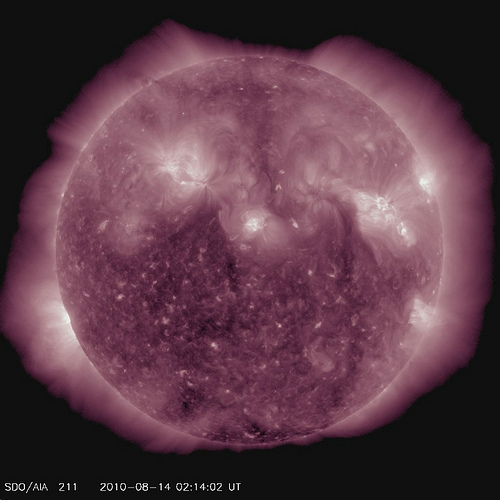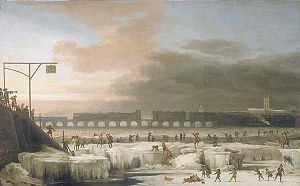With the debate focused on a warming Earth, the icy consequences of a cooler future have not been considered
You probably haven’t heard much of Solar Cycle 24, the current cycle that our sun has entered, and I hope you don’t. If Solar Cycle 24 becomes a household term, your lifestyle could be taking a dramatic turn for the worse. That of your children and their children could fare worse still, say some scientists, because Solar Cycle 24 could mark a time of profound long-term change in the climate. As put by geophysicist Philip Chapman, a former NASA astronaut-scientist and former president of the National Space Society, “It is time to put aside the global warming dogma, at least to begin contingency planning about what to do if we are moving into another little ice age.
The Frozen Thames, 1677. (Photo credit: Wikipedia)
The sun, of late, is remarkably free of eruptions: It has lost its spots. By this point in the solar cycle, sunspots would ordinarily have been present in goodly numbers. Today’s spotlessness” what alarms Dr. Chapman and others” may be an anomaly of some kind, and the sun may soon revert to form. But if it doesn’t” and with each passing day, the speculation in the scientific community grows that it will not” we could be entering a new epoch that few would welcome.
Sunspots have been well documented throughout human history, starting in the fourth century BC, with written descriptions by Gan De, a Chinese astronomer. In 1128, an English monk, John of Worcester, was the first person known to have drawn sunspots, and after the telescope’s arrival in the early 1600s, observations and drawings became commonplace, including by such luminaries as Galileo Galilei. Then, to the astonishment of astronomers, they saw the sunspots diminish and die out altogether.
This was the case during the Little Ice Age, a period starting in the 15th or 16th century and lasting centuries, says NASA’s Goddard Space Centre, which links the absence of sunspots to the cold that then descended on Earth. During the coldest part of the Little Ice Age, a time known as the Maunder Minimum (named after English astronomer Edward Maunder), astronomers saw only about 50 sunspots over a 30-year period, less than one half of 1% of the sunspots that would normally have been expected. Other Minimums” times of low sunspot activity” also corresponded to times of unusual cold.
The consequences of the Little Ice Age, because they occurred in relatively recent times, have come down to us through literature and the arts as well as from historians and scientists, government and business records. When Shakespeare wrote of “lawn as white as driven snow,†he had first-hand experience” Europe was bitterly cold in his day, a sharp contrast to the very warm weather that preceded his birth. During the Little Ice Age, the River Thames froze over, the Dutch developed the ice skate and the great artists of the day learned to love a new genre: the winter landscape.
In what had been a warm Europe , adaptations were not all happy: Growing seasons in England and Continental Europe generally became short and unreliable, which led to shortages and famine. These hardships were nothing compared to the more northerly countries: Glaciers advanced rapidly in Greenland, Iceland, Scandinavia and North America, making vast tracts of land uninhabitable. The Arctic pack ice extended so far south that several reports describe Eskimos landing their kayaks in Scotland. Finland’s population fell by one-third, Iceland’s by half, the Viking colonies in Greenland were abandoned altogether, as were many Inuit communities. The cold in North America spread so far south that, in the winter of 1780, New York Harbor froze, enabling people to walk from Manhattan to Staten Island.
In the same way that the Earth shivered when sunspots disappeared, the Earth warmed when sunspot activity became pronounced. The warm period about 1000 years ago known as the Medieval Warm Period” a time of bounty in which grapes grew in England and Greenland was colonized” also was a time of high sunspot activity, called the Medieval Maximum. Since 1900, Earth has experienced what astronomers call “the Modern Maximum” the 20th century has again been a time of high sunspot activity.
But the 1900s are gone, along with the high temperatures that accompanied them. The last 10 years have seen no increase in temperatures” they reached a plateau and then remained there” and the last year saw a precipitous decline. How much lower and for how long the temperatures will fall, if at all, no one yet knows” the science is far from settled on what drives climate.
But many are watching the sun for answers, and for good reason. Several renowned scientists have been predicting for some time that the world could enter a period of cooling right around now, with consequences that could be dire. “The next little ice age would be much worse than the previous one and much more harmful than anything warming may do,†believes Dr. Chapman. “There are many more people now and we have become dependent on a few temperate agricultural areas, especially in the U.S. and Canada. Global warming would increase agricultural output, but global cooling will decrease it.â€
We are now at the beginning of Solar Cycle 24, so named because it is the 24th consecutive cycle that astronomers have listed, starting with the first cycle that began in March, 1755, and ended in June, 1766. Each cycle lasts an average of approximately 11 years; each is marked by sunspots that first erupt in the mid latitudes of the sun, and then, over the course of the 11 years, erupt progressively toward the sun’s equator; each is marked by a change in the polarity of the sun’s hemispheres; each changes the temperature on Earth in ways that humans don’t fully understand, but cannot in all honesty deny.
Lawrence Solomon is executive director of Energy Probe and author of The Deniers: The world-renowned scientists who stood up against global warming hysteria, political persecution, and fraud.
LawrenceSolomon@nextcity.com








